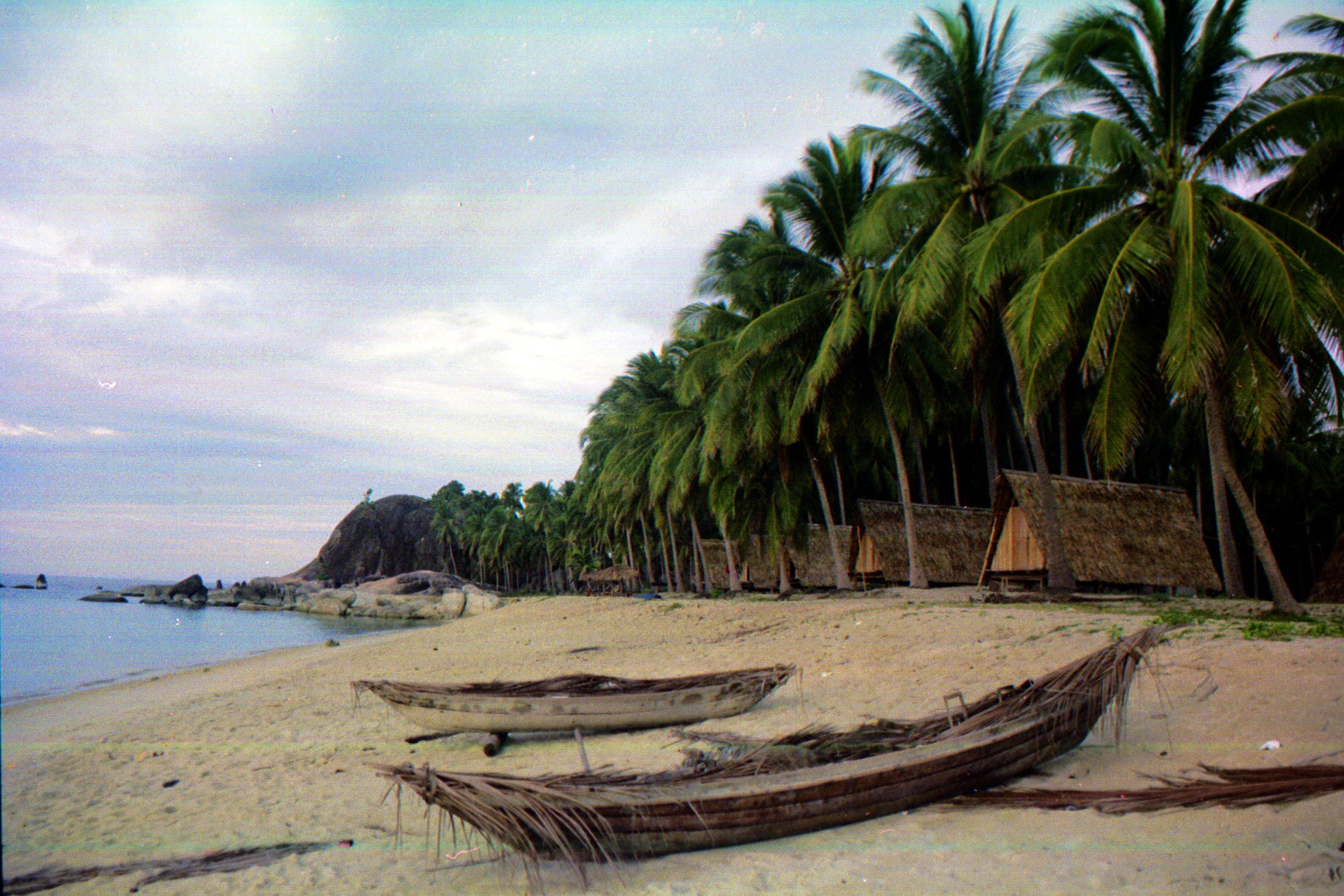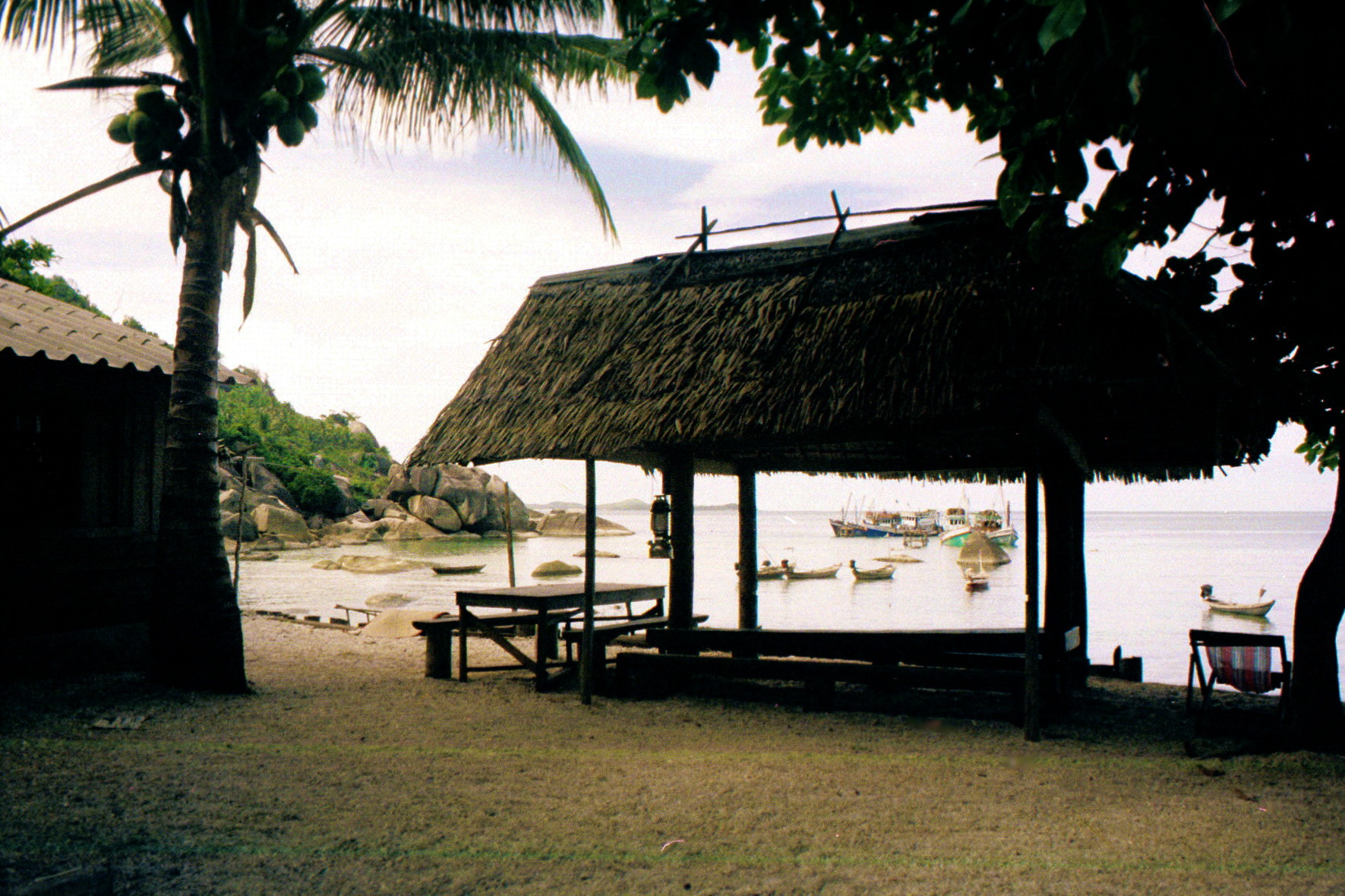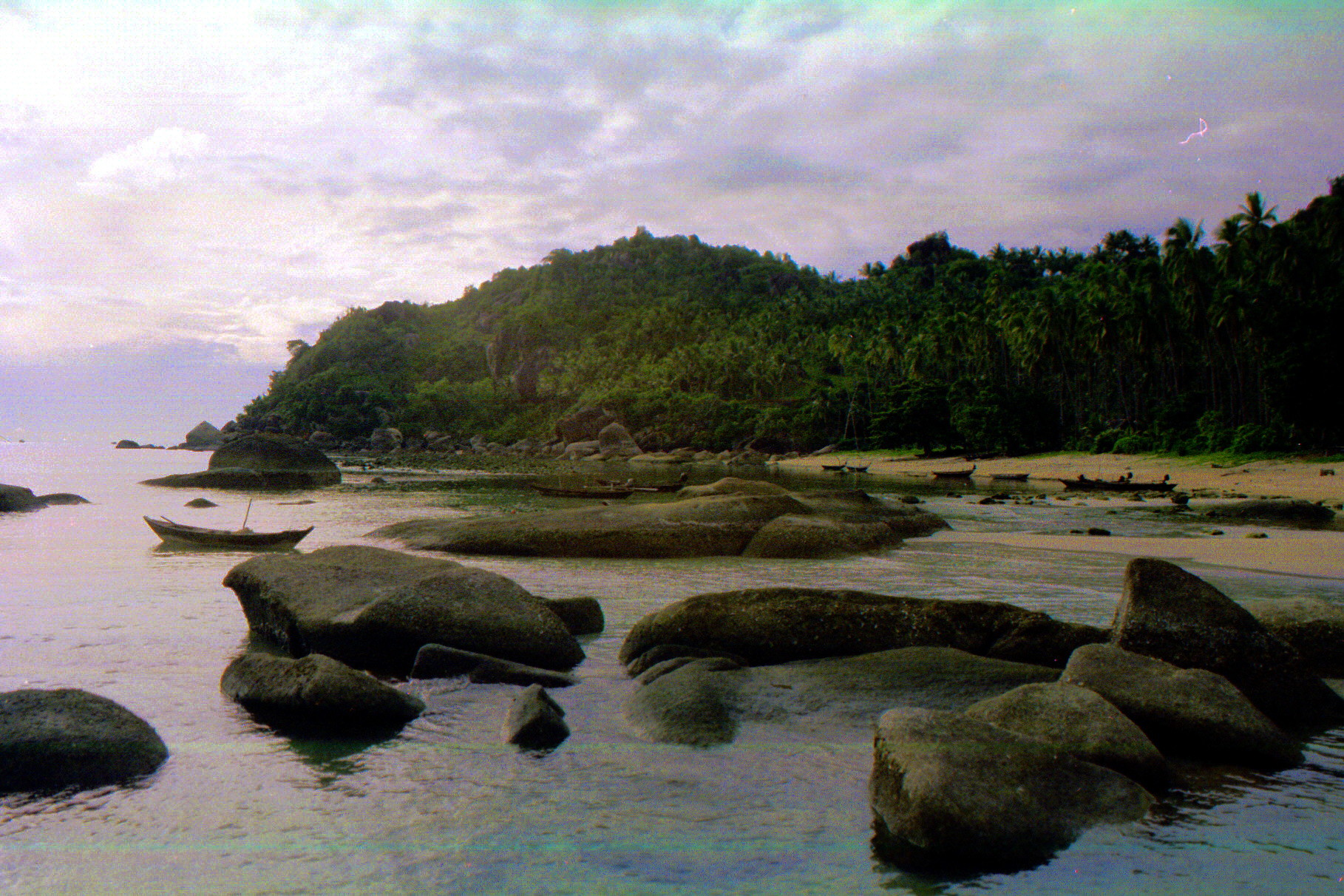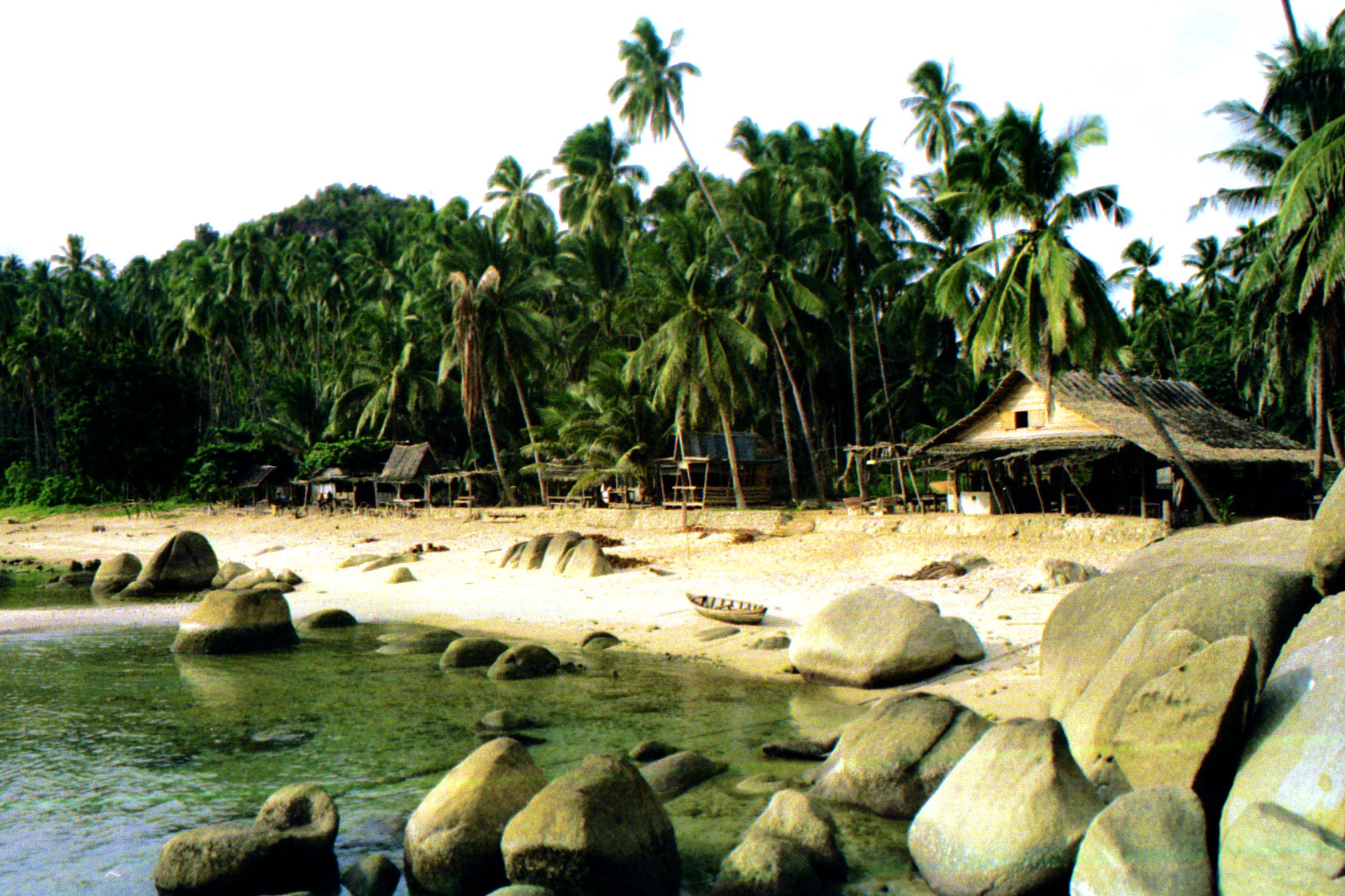
I flew from Rangoon to Bangkok. I spent a few days in Bangkok and then took an overnight train to Chiangmai. From there I did a trek out of Fang, near Chiangrai. I went back to Bangkok by bus, to Koh Samui by train and boat and then on to Phuket by bus. I went from Phuket to Penang by bus and train.
My original plan was to try to get into Laos. I went to the train station in Bangkok and tried to inquire about a train to Nong Khai, across the Mekong River from Vientiane, Laos. The guy at the information counter took out a map, drew a big black X over the entire northeast of Thailand and just said, "No". I still have no idea why I was not permitted to travel to that part of Thailand. There was a "communist" insurgency going on at that time, but most of the northeast was perfectly safe. I went to Chiangmai instead.

I spent the first few days in Bangkok. I stayed at the infamous Thai Song Greet hotel. I visited the Grand Palace and Wat Po on the first day. This is the grounds of the Grand Palace.

Grand Palace

Grand Palace

Bottom of the foot of the reclining Buddha at Wat Po.

I spent one day visiting the Red Cross Snake Farm, having a drink at the wonderful old Siam Intercontinental Hotel and the Jim Thompson House Museum, above.

Jim Thompson was the founder of the Thai Silk company. He was OSS station chief in Bangkok at the end of World War II, but stayed on in Thailand and lead the revival of the Thai silk industry. Thompson disappeared in the Cameron Highlands in Malaysia while on vacation in 1967. His beautifully decorated home is open to visitors as a museum.

Jim Thompson House Museum

After a couple of days in Bangkok I took an overnight train to Chiangmai. I took time to see a few of the many temples, but my main goal was to do a trek into the Golden Triangle area, where Thailand, Burma and Laos all meet.

Chiangmai

I took a "hill tribe" trek out of Chiangmai. We went to Chiang Rai by truck and then on toward Fang by bamboo raft on the Kok River.

We left the raft and hiked for three days. This is some clever hill tribe bamboo pipe irrigation.

We stayed in village homes each night of the trek. As was common at the time we were offered opium to smoke at most stops. This was during rainy season, so we got pretty wet at times.

There are hill tribe villages scattered all over the place. But, they tend to move a lot to let the land go fallow for a while.

I think this weaver is from the Karen tribe. The white dress indicates she is unmarried.

This is an Akha village. The headdresses contain beads, feathers and dangling silver ornaments, including old silver coins.

They wanted to be paid to be photographed.

Water buffalo cart for transport to the Akha village.

Water powered rice mill.

Akha village in the distance.

These Akha villages were not to clean with pigs and pig crap all over the place.

Akha women

The woman liked to smoke, but this was the only pipe I saw.

Another smoker

Akha villages have a "spirit" gate. Inside the gate is the domain of people and domesticated animals. Outside the gate is the domain of nature and spirits. The gates usually have a carving of a man and woman.

Back in Chiangmai. Temple band.

Typical northern (Lanna) style temple in Chiangmai. This is Wat Chiang Man

This is the Elephant Chedi at Wat Chiang Man

From Chiangmai I took a terrifying overnight highway bus to Bangkok and then got an overnight train to Surat Thani where I got the ferry for Koh Samui. On the ferry I sat next to an old woman who wore a bright white and nicely starched blouse. She was using a bamboo mortar and steel pestle to mash a mix of betel nut, lime paste and pepper leaves. By the time we got to Samui the betel nut juice had dribbled down her chin and all over that nice clean blouse.
From the pier on the west side of the island we (me and a couple of guys from Jersey) hitched a ride in a pickup truck all the way around to Lamai Beach. At that time there was only one this one place to stay at Lamai; very nice A-frame cabins. Lamai Beach doesn't look much like this anymore. We stayed here one night and then went to the end of the passable road which was at Ao Thong Takhian.
Back in 1977 about the only visitors to Samui were backpackers. The following paragraph is everything Tony Wheeler had to say about Koh Samui in the 1977 edition of 'Southeast Asia on a Shoestring':
"Ko Samui - A beautiful and so far un-touched island off the east coast. Nice by itself or a base to reach other nearby islands. To get there get to Surat Thani and then take a boat from Band Don (a 5B bus ride from Surat Thani) every day at midnight and returning at 23.00 -- the six-hour trip costs 15B deck or 25b cabin class. Or you can do it in half the time for the same fare on the 12:30 speedboat service, it returns from Ko Samui at 07.30."

I ended up spending a week at Ao Tong Takhian. It was a lovely spot. No other travelers. Nothing going on. It cost, I think, 20 baht (fifty US cents at the time) per night, including a simple breakfast. We spent the days snorkeling, hiking and reading. We spent the evenings drinking Lao Cao (white lightening) and smoking Thai Stick provided by the proprietor of the establishment at no extra charge. Ao Tong Takhian is now known as Crystal Bay or Silver Bay. It is lined with hotels and full of tourists.

Ao Thong Takhian - Samui. This fleet mainly fished for squid and cuttle fish. The other parts of the catch were sold locally and were included in our daily meals.
One day after a brief disagreement over some missing rubber slippers the fishermen invited me out to one of the boats where we smoked a bong full of some incredibly strong marijuana mixed with sandalwood shavings.

Snorkeling in and around these boulders was wonderful. In spite of all the subsequent development, snorkeling here is still pretty good.

Ao Tong Takhian - I slept in a plywood shack under the coconut trees. Meals were served in the large building. The wooden canoe was used by the fishermen to get out to their fishing boats in the bay.

Crystal clear water. Hat Chaweng in the distance. There was a four-wheel-drive only dirt tack that went from Thong Takhian up over the cliff and down into South Chaweng.

One day we walked on the dirt track over to Chaweng. The beach was beautiful. There were just a few cottages for travelers and the main industry seemed to be oysters. You can see the huge piles of oyster shells to the center left.

Looking south from the road to Chaweng down to the squid fleet at Ao Thong Takhian. The rough road is visible at the lower right.

Pigtailed macaques are trained to pick coconuts. I guess this guy is off to work. At that time coconuts were still one of the main enterprises on Koh Samui.

From Ko Samui I took a bus to Phuket where I stayed a few days at Kata beach. Sadly, no photos survived. From Phuket I took the train down into Malaysia and visited Penang.

This photo is not in great shape. I believe it was taken on the train somewhere south of Surt Thani on the way to Malaysia. The myst shrouded rock formation is limestone.
| Introduction | England | Scotland | Europe |
| Turkey | Iran | Afghanistan | Pakistan |
| India 1 | India 2 | Nepal | Burma |
| Thailand | Malaysia/Singapore | Indonesia 1 | Indonesia 2 |
| Hong Kong | Macau | Japan | Korea |
Photographs and text copyright Michael Newman and William Garsden: 2025